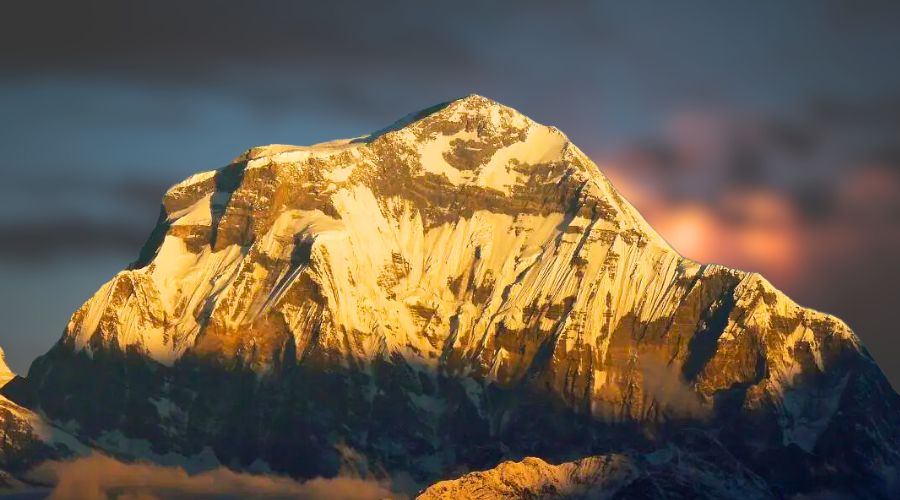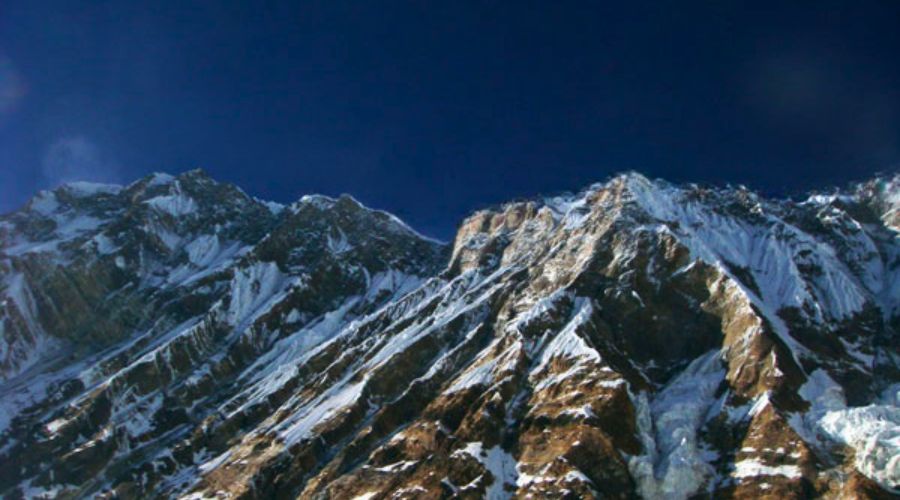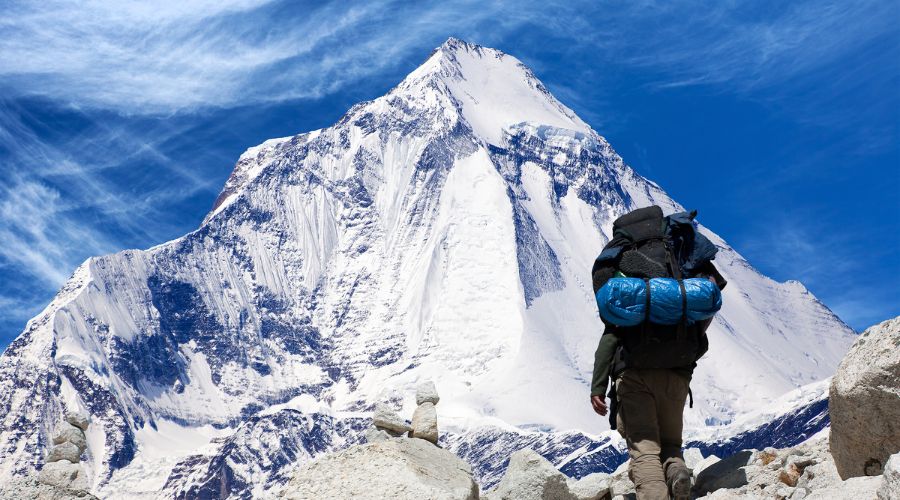
Dhaulagiri South Face

Dhaulagiri South Face
swotah travel
3977
15, 05 2023
One of the world's most intimidating and breathtaking mountain faces is the South face of Dhaulagiri. Dhaulagiri, the seventh-highest mountain in the world which is located in Nepal, is notable for its challenging south face.
One of the most prominent mountains in the Himalayas is Dhaulagiri, which translates to "White Mountain" in Nepali and it rises 8,167 meters (26,795 ft) above sea level. The South Face is regarded as one of the hardest and deadliest routes among the numerous routes that lead to the top of Dhaulagiri.
The article below will explain the history, geography, and challenges one might face while embarking upon the difficult expedition of one of the most stunning faces of mountains on earth i.e. the South face of Dhaulagiri.
A bit of history
One of the tallest mountains in the world, Dhaulagiri is situated in the Annapurna area and is 8167 meters above sea level. It is a piece of the Dhaulagiri Range, which stretches between the Bheri River in the east and the Kali Gandaki Gorge in the west. Kali Gandaki Gorge is considered one of the world's deepest gorges.
A Swiss, Austrian, and Nepali expedition under the direction of Max Eiselin made the first successful ascent to the summit of Dhaulagiri on May 13, 1960. The climbers had to contend with ferocious storms, deep snow, sloping terrain, and unexpected avalanches, which presented them with formidable challenges. After 12 days of arduous climbing, they managed to reach the summit despite these obstacles. The typical North-East ridge was used to complete the climb.
Moreover, after a lot of unsuccessful attempts, the first true South face Dhaulagiri expedition was completed by the Yugoslav team in 1981. This expedition was not just a regular expedition like others because it was completed in Alpine style(i.e., without oxygen). This quest to conquer the mighty Dhaulagiri took roughly 15 days from Base Camp to Beni (a village in Nepal).
Many mountaineers have tried to climb the mountain's South face since that time. Some of them, including the Slovenian alpinist Tomaz Humar, have even succeeded in scaling the South face by himself. Climbing the South Face has remained a challenging objective for many mountaineers because of its technical character.

Photo: A photograph of the late mountaineer Tomaz Humar
Whatever their motivation may be, most climbers agree that scaling Dhaulagiri’s South face is a formidable challenge that requires skill and determination. Although fewer people have succeeded in conquering it, many are still determined to take on this thrilling challenge.
More detail on the first successful climb on Mount Dhaulagiri via South Face
On September 12, 1981, six alpinists accompanied by Milan Khadka(liaison officer), five Nepalese staff, and 56 porters embarked upon the journey to the Dhaulagiri South face from Pokhara. They reached the Dhaulagiri Base camp on 23rd September which is located at an elevation of 3950m.
Because of bad weather and for acclimatization, climbers were only able to reach the elevation of 5300m until October 14. However, on October 15, Stane Belak, Cene Bercic, and Emil Tratnik left their tents and climbed to 5700 meters, challenged by falling stones for 7 hours at an elevation of 5300m.
On October 17, they were able to reach an altitude of 6100m, moving along icefields and rocky terrain.

Photo: South Dhaulagiri Route
Rok Kolar and Joze Zupan started on October 18 and reached the tent at 5100m. However, they had to descend to meet Janez Sabolek, their sixth expedition companion.
On October 19, despite only 5-6 hours of climbing, they reached an altitude of 6900m.
They reached the rock band in the south-west ridge on October 20, which was situated at an elevation of 7300m. The ropes used by the Japanese expedition in 1978 were still intact. This was the day history was made as they successfully climbed via the South Face.
On October 21, they could only scale 100 meters of height after a bad night.
Afterward, on 22nd October, they reached an elevation of 7550 m after a windy and cold night. They were only able to ascend roughly about 150 m on this day.
Moving on, they reached the right-hand edge just below the mountain on the 23rd of October. It is situated at an altitude of 7800 m.
Finally, on 24th October, they planned on ascending to the base camp. However, the mighty Dhaulagiri was in full mood to add obstacles on their way down. The gas stove stopped functioning, icy winds buried the tents and the bone-chilling cold tested their spirits. They moved quickly to reach the South East ridge which is at an elevation of 7950 m. Afterward, they took the north slope and descended to 7200m. Luckily, they found some usable abandoned tents, most probably left out by the Japanese. The communication with Base Camp had failed at this point in time.
On October 25, they climbed down via the North Rib. Dhaulagiri was still testing their endurance as bad weather was swiftly approaching via the west. In addition to a lack of food, 20cm thick snow made their life miserable during the night.
However, despite all the odds, they descended to an altitude of 6,000 m on 26th October and took shelter in a crevasse.
On October 27, they reached Tak Khole, situated at an altitude of 6090 m, walking through 60 cm of snow. They rapidly descended further and reached an elevation of 4800 m after 7 hours of continuous walking. Here, they again took shelter in a crevasse.
During the daytime of October 28, after 12 hours of continuous descent, they reached an elevation of 4200 m and took shelter in snow-covered pastures. To this day, they had no communication with the outside world.
Fortunately, they were able to meet other people on the 29th of October after reaching the village of Kala Pani. After 6 days of tackling the dreadful challenges on an empty stomach, they were able to fill their belly.
The expedition finally ended on October 30 in the village of Beni where they united with the rest of their companions. On 16th November, they were finally back home to tell the tale of one of the greatest expeditions in history.
What to expect when climbing?
It is necessary to be prepared prior to attempting a climb via Dhaulagiri's South Face. If you want to climb Dhaulagiri's South Face, there is a challenging, steep trail that leads to the mountain's peak, which is 8,167 meters above sea level. Expect to go roughly 30 kilometers overall and gain 7800 meters in height.
The South Face is a difficult climb that is not recommended for the weak of the heart. Technical climbing proficiency and high physical and mental preparation are required. Expect avalanches, rock walls, and steep icy slopes. You should always take all required precautions while climbing because the terrain might be hazardous and unpredictable.
On the mountain, you should anticipate harsh weather as well. Given that temperatures can dip well below 0 degrees Celsius, you should be outfitted with the right gear. Symptoms including headaches, nausea, and dizziness might also result from being at a high altitude. These symptoms should be recognized asap and you ought to be ready to act appropriately if they do.

Schedule lengthy stays on the mountain throughout your climb to give yourself adequate time to acclimatize. Depending on the route you take, the ascent could take between 14 and 16 days. Make sure you have the tools necessary for a challenging climb before you start and prepare accordingly.
It will take a lot of devotion and perseverance to scale Dhaulagiri's South Face, which is an extraordinary task. Take all required measures while on the mountain and be ready for a lengthy, maybe hazardous expedition. You may climb this magnificent mountain and take in the stunning scenery from its summit with the right planning and a little bit of fortune.
Tips for a successful climb
It takes considerable skill to ascend Dhaulagiri's South Face. It requires both physical and mental courage, as well as careful planning. Here are some suggestions to help you have a smooth ascent.
First and foremost, do your research. Learn as much as you can about the route, the terrain, and the conditions. Research the history of the mountain, who has climbed it before, and what challenges they faced. Consider hiring an experienced guide along with porters if you are inexperienced in climbing mountains of this size.
Make certain you have the appropriate tools for the job. Invest in high-altitude mountaineering boots, crampons, an ice axe, and carabiners which are quality equipment made for harsh alpine conditions. If required, explore renting or purchasing equipment.
Fitness and appropriate training are equally significant if you want to increase the chances of a successful climb. At least three months prior you attempt the climb, and begin a cardio, stamina, and strength-training routine. By doing this, you can boost your capacity for the ascent and reduce your chance of getting hurt.
Finally, before tackling the summit, be careful to thoroughly acclimatize to the altitude. Your body will adapt to the shift in the environment by beginning at a lower altitude and progressively ascending to greater altitudes. To assist your body in adjusting, make sure to often hydrate and take breaks.
You can successfully climb Dhaulagiri's South Face by considering this advice. You can reach the top and take in the views from one of the highest peaks in the world with the right planning and training.
Why is the South face challenging?
The South Face is renowned for its rough terrain, significant height variations, and erratic weather.
Individuals need to be highly skilled mountaineers in order to ascend the South face. With several hazardous crevasses, rockfalls, and strong winds that can blow up to 80 miles per hour, the landscape is very exposed and steep. Furthermore, because there are many routes that require the use of ice axes and crampons, the South Face needs technical climbing expertise.
An effective ascent may become much more challenging because of the weather. The South face is vulnerable to rapid variations in temperature and snowfall because of its presence in the Himalayas. On the peak, low visibility is frequent due to cloudiness, heavy snowfall, and lightning storms. Climbers must be prepared to navigate in challenging situations with little to no visibility if that's the case.
The elevation is a problem as well. Oxygen levels drastically decrease when climbers get closer to the summit, making breathing difficult. Altitude sickness, which can bring on headaches, dizziness, and nausea can result from high altitude. Climbers must take frequent breaks to acclimatize and must also consume a lot of fluids and high-energy food.
Finally, it is important to remember the mountain's immense size. The sheer size of Dhaulagiri can even intimidate seasoned mountaineers.
In summary, the South face of Dhaulagiri is one of the most challenging mountain faces in the world. It requires skill, knowledge, and determination to successfully climb this majestic peak. With its unpredictable weather patterns, steep terrain, and high altitude, only those who are truly dedicated should attempt a climb of the South face.
Conclusion
For adventurers who are motivated and ambitious enough to attempt it, the South face of Dhaulagiri is a tough achievement. It takes a great level of technical expertise, physical fitness and mental discipline to ascend up the face, so it's not for the weak of the heart. It takes a lot of planning and commitment to climb this enormous mountain because of its tremendous heights, crevasses, glaciers, and ice ridges.
That being said, the rewards are tremendous. Reaching the summit of Dhaulagiri via the South is a feat that few can accomplish and the feeling of accomplishment is incomparable. If you’re up for the challenge, start your journey today and get ready to experience the adventure of a lifetime.
NEWSLETTER SIGNUP
Sign up to receive our trip ideas and travel offers!
Get updates and Exclusive Offers up to 20% Discount








